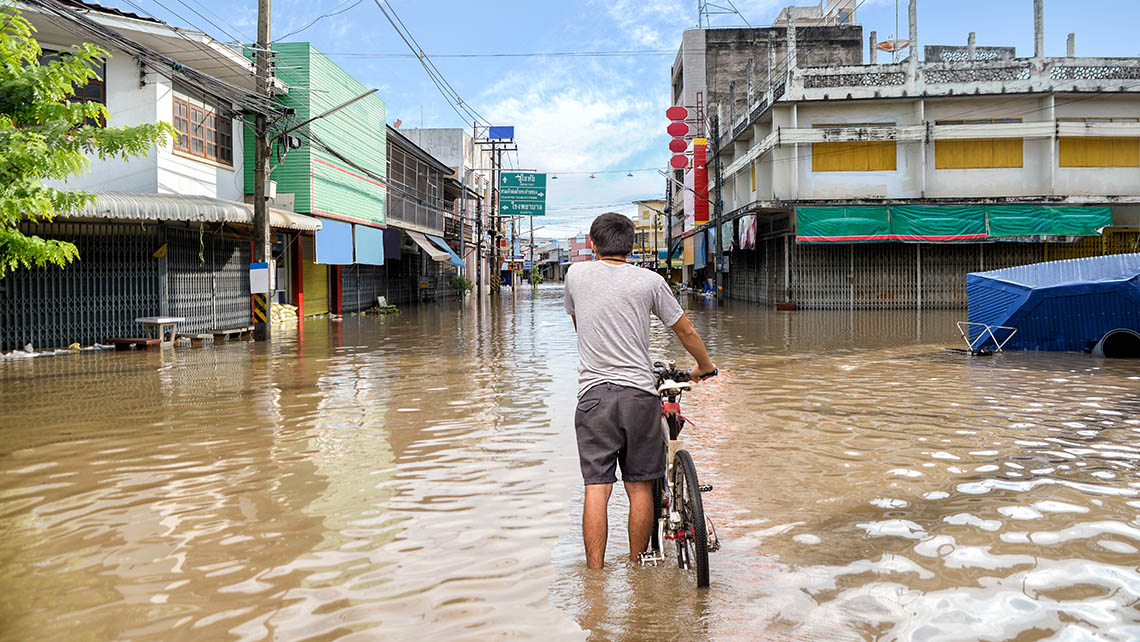Chances are your WWTP is already struggling with flooding or intense droughts, both of which have worsened in recent years because of climate change. Large volumes of stormwater can easily overwhelm treatment plants. Meanwhile, dry hot places are getting even drier. Neither situation is good. Both put stress on clean water availability and often lead to negative consequences for the natural environment and local communities.
Fortunately, there are solutions to support WWTPs with climate change adaptation. Facilities can manage stormwater overflows better with chemical treatment. Those in arid areas can scale up water reuse.
Solving the stormwater issue
If you work in an increasingly rainy locale, stormwater conditions will sound familiar. They occur when a WWTP or sewage network cannot handle the huge influx of wastewater caused by heavy rainstorms or snow melt. Combined sewer overflow (CSO) ─ when the capacity of a sewage system has reached its limit ─ causes wastewater to be released with little or no treatment. This can happen, for example, at a pumping station when there’s not enough capacity to forward all the water.
These stormwater events often impact natural waterways. Of course, this reflects poorly on the WWTP. Since WWTPs normally remove >90-95% of the impurities from wastewater, a minor release of untreated water can have a significant impact. Phosphorus and bacteria are usually the biggest concerns.
Facilities can manage stormwater overflows better with chemical treatment. Those in arid areas can scale up water reuse.
What can you do when a system is under stress? First, take a look at the most sensitive area. It’s usually biological treatment. The secondary sedimentation capacity tends to be insufficient and more suspended solids (SS) are released. One way to solve this problem is to dose a small amount of polymer in the influent to the secondary settling tanks. Adding the polymer allows the surface load on the secondary sedimentation to be increased. Both anionic and cationic polyacrylamides are options; the charge depends on the sludge characteristics.
Sometimes part of the wastewater needs to bypass the biological treatment step if the flow is too high. Otherwise, there is a risk that activated sludge gets flushed away. In this case, the water is typically still subject to primary treatment. However, in extreme situations even the primary treatment might be bypassed. Here, too, chemical treatment can help. The idea is to rapidly remove as many impurities as possible. Coagulants and flocculants are usually the most effective combination. The coagulants agglomerate the small particles while the flocculants build strong flocs that can handle tougher conditions.
Amazingly, chemical treatment makes it possible to reach efficiency levels similar to a well-working direct precipitation plant. BOD can be removed to around 75%. SS and phosphorus can be removed above 90%. Bacteria are also removed to a great extent.
Read more about solutions for stormwater conditions in our Water Handbook.
Reusing water in dry times
Of course, many plants face a drastically different issue: drought. In some regions, this is a perpetual issue that is getting worse. In other areas, drought is seasonal but increasingly problematic. We recommend preparing for dry times by implementing water reuse. Also called water recycling or water reclamation, you can help tackle waster scarcity by reusing water in a way that’s fit for purpose.
Today, places like California and Singapore treat municipal wastewater and use it to recharge aquifers, prevent saline water intrusion, and to support irrigation, agriculture and industry. The treated water often has the same or better quality as fresh water.
For water reuse, membranes are the go-to technology. Whether you choose ultrafiltration (UF), microfiltration (MF) or reverse osmosis (RO), there are some challenges. The main issue with membrane technology tends to be fouling, which reduces performance and increases costs. It’s impossible to stop fouling completely, but you can reduce the impact through chemistry-enabled process optimization.
Coagulants and flocculants play key roles. For example, with RO, the feed water needs to be very clean, so pre-treatment is of utmost importance. Inorganic coagulants like iron salts (e.g. ferric sulfate and ferric chloride) are usually ideal. Flocculants on the other hand can cause blockages if not chosen carefully. Residual flocculants can stick to the membrane. We recommend a very low dose of anionic flocculants (<0.5 ppm) and even lower doses for cationic flocculants (<0.2 ppm), only if needed.
Read the Water Handbook to learn more about these and other chemistries such as biocides and antiscalants.
Making good on the Paris Agreement
Facing extreme weather is one thing but looking to the future is quite another. It’s not only a matter of how to operate in a world in which climate change already exists. The question is how can WWTPs help slow down the human impacts?
That’s where climate mitigation comes in. Many utilities are setting ambitious sustainability targets that will drastically lower their carbon footprint over the next decades. While you might immediately think of renewable energy like solar panels as the main means of achieving your emissions-related goals, there are digital solutions and chemical solutions that can also optimize energy and resources.
We encourage WWTPs to explore all options and take a holistic approach. Together we can ensure clean water for everyone while taking action on climate change.


